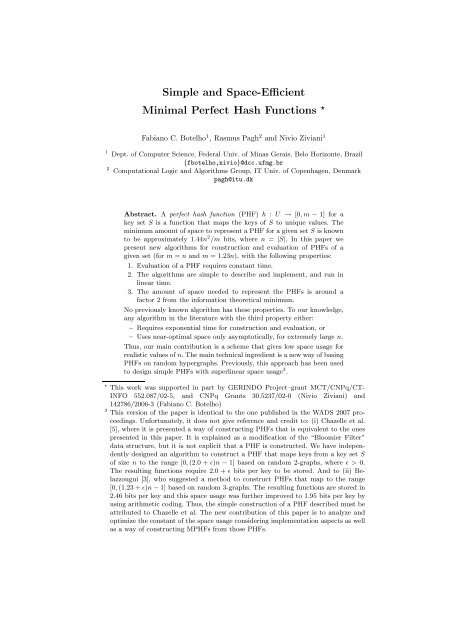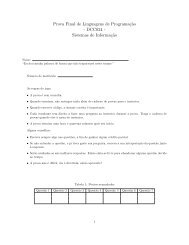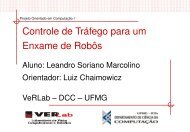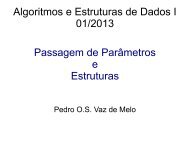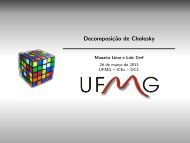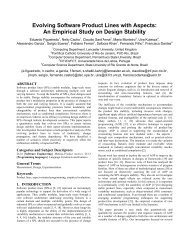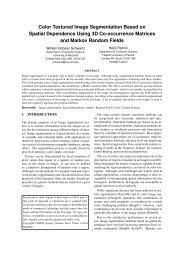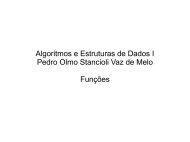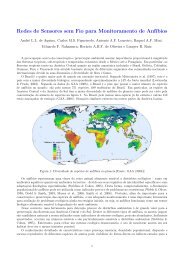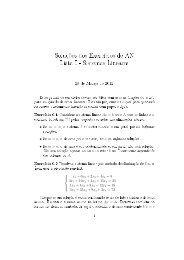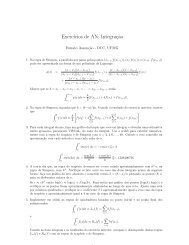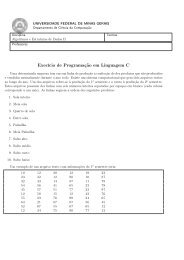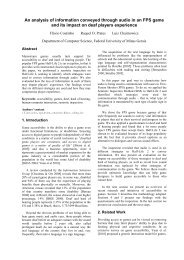Simple and Space-Efficient Minimal Perfect Hash Functions * - Liacs
Simple and Space-Efficient Minimal Perfect Hash Functions * - Liacs
Simple and Space-Efficient Minimal Perfect Hash Functions * - Liacs
Create successful ePaper yourself
Turn your PDF publications into a flip-book with our unique Google optimized e-Paper software.
<strong>Simple</strong> <strong>and</strong> <strong>Space</strong>-<strong>Efficient</strong><br />
<strong>Minimal</strong> <strong>Perfect</strong> <strong>Hash</strong> <strong>Functions</strong> ⋆<br />
Fabiano C. Botelho 1 , Rasmus Pagh 2 <strong>and</strong> Nivio Ziviani 1<br />
1 Dept. of Computer Science, Federal Univ. of Minas Gerais, Belo Horizonte, Brazil<br />
{fbotelho,nivio}@dcc.ufmg.br<br />
2 Computational Logic <strong>and</strong> Algorithms Group, IT Univ. of Copenhagen, Denmark<br />
pagh@itu.dk<br />
Abstract. A perfect hash function (PHF) h : U → [0, m − 1] for a<br />
key set S is a function that maps the keys of S to unique values. The<br />
minimum amount of space to represent a PHF for a given set S is known<br />
to be approximately 1.44n 2 /m bits, where n = |S|. In this paper we<br />
present new algorithms for construction <strong>and</strong> evaluation of PHFs of a<br />
given set (for m = n <strong>and</strong> m = 1.23n), with the following properties:<br />
1. Evaluation of a PHF requires constant time.<br />
2. The algorithms are simple to describe <strong>and</strong> implement, <strong>and</strong> run in<br />
linear time.<br />
3. The amount of space needed to represent the PHFs is around a<br />
factor 2 from the information theoretical minimum.<br />
No previously known algorithm has these properties. To our knowledge,<br />
any algorithm in the literature with the third property either:<br />
– Requires exponential time for construction <strong>and</strong> evaluation, or<br />
– Uses near-optimal space only asymptotically, for extremely large n.<br />
Thus, our main contribution is a scheme that gives low space usage for<br />
realistic values of n. The main technical ingredient is a new way of basing<br />
PHFs on r<strong>and</strong>om hypergraphs. Previously, this approach has been used<br />
to design simple PHFs with superlinear space usage 3 .<br />
⋆ This work was supported in part by GERINDO Project–grant MCT/CNPq/CT-<br />
INFO 552.087/02-5, <strong>and</strong> CNPq Grants 30.5237/02-0 (Nivio Ziviani) <strong>and</strong><br />
142786/2006-3 (Fabiano C. Botelho)<br />
3 This version of the paper is identical to the one published in the WADS 2007 proceedings.<br />
Unfortunately, it does not give reference <strong>and</strong> credit to: (i) Chazelle et al.<br />
[5], where it is presented a way of constructing PHFs that is equivalent to the ones<br />
presented in this paper. It is explained as a modification of the “Bloomier Filter”<br />
data structure, but it is not explicit that a PHF is constructed. We have independently<br />
designed an algorithm to construct a PHF that maps keys from a key set S<br />
of size n to the range [0,(2.0 + ǫ)n − 1] based on r<strong>and</strong>om 2-graphs, where ǫ > 0.<br />
The resulting functions require 2.0 + ǫ bits per key to be stored. And to (ii) Belazzougui<br />
[3], who suggested a method to construct PHFs that map to the range<br />
[0, (1.23 + ǫ)n − 1] based on r<strong>and</strong>om 3-graphs. The resulting functions are stored in<br />
2.46 bits per key <strong>and</strong> this space usage was further improved to 1.95 bits per key by<br />
using arithmetic coding. Thus, the simple construction of a PHF described must be<br />
attributed to Chazelle et al. The new contribution of this paper is to analyze <strong>and</strong><br />
optimize the constant of the space usage considering implementation aspects as well<br />
as a way of constructing MPHFs from those PHFs.
1 Introduction<br />
<strong>Perfect</strong> hashing is a space-efficient way of associating unique identifiers with the<br />
elements of a static set S. We will refer to the elements of S as keys. A perfect<br />
hash function (PHF) maps S ⊆ U to unique values in the range [0, m − 1]. We<br />
let n = |S| <strong>and</strong> u = |U| — note that we must have m ≥ n. A minimal perfect<br />
hash function (MPHF) is a PHF with m = n. For simplicity of exposition, we<br />
consider in this paper the case log u ≪ n. This allows us to ignore terms in the<br />
space usage that depend on u.<br />
In this paper we present a simple, efficient, near space-optimal, <strong>and</strong> practical<br />
family F of algorithms for generating PHFs <strong>and</strong> MPHFs. The algorithms in F<br />
use r-uniform r<strong>and</strong>om hypergraphs given by function values of r hash functions<br />
on the keys of S. An r-uniform hypergraph is the generalization of a st<strong>and</strong>ard<br />
undirected graph where each edge connects r ≥ 2 vertices. The idea of basing<br />
perfect hashing on r<strong>and</strong>om hypergraphs is not new, see e.g. [16], but we will<br />
proceed differently to achieve a space usage of O(n) bits rather than O(n log n)<br />
bits. (As in previous constructions based on hypergraphs we assume that the<br />
hash functions used are uniformly r<strong>and</strong>om <strong>and</strong> have independent function values.<br />
However, we argue that our scheme can also be realized using explicitly defined<br />
hash functions using small space.) Evaluation time for all schemes considered<br />
is constant. For r = 2 we obtain a space usage of (3 + ǫ)n bits for a MPHF,<br />
for any constant ǫ > 0. For r = 3 we obtain a space usage of less than 2.7n<br />
bits for a MPHF. This is within a factor of 2 from the information theoretical<br />
lower bound of approximately 1.4427n bits. More compact, <strong>and</strong> even simpler,<br />
representations can be achieved for larger m. For example, for m = 1.23n we<br />
can get a space usage of 1.95n bits. This is slightly more than two times the<br />
information theoretical lower bound of around 0.89n bits. The bounds for r = 3<br />
assume a conjecture about the emergence of a 2-core in a r<strong>and</strong>om 3-partite<br />
hypergraph, whereas the bounds for r = 2 are fully proved. Choosing r > 3 does<br />
not give any improvement of these results.<br />
We will argue that our method is far more practical than previous methods<br />
with proven space complexity, both because of its simplicity, <strong>and</strong> because the<br />
constant factor of the space complexity is more than 6 times lower than its closest<br />
competitor, for plausible problem sizes. We verify the practicality experimentally,<br />
using heuristic hash functions, <strong>and</strong> slightly more space than in the mentioned<br />
theoretical bounds.<br />
2 Related Work<br />
In this section we review some of the most important theoretical <strong>and</strong> practical<br />
results on perfect hashing. Czech, Havas <strong>and</strong> Majewski [6] provide a more<br />
comprehensive survey.
2.1 Theoretical Results<br />
Fredman <strong>and</strong> Komlós [11] proved that at least n log e+loglog u−O(log n) bits are<br />
required to represent a MPHF (in the worst case over all sets of size n), provided<br />
that u ≥ n α for some α > 2. Logarithms are in base 2. Note that the two last<br />
terms are negligible under the assumption log u ≪ n. In general, for m > n the<br />
space required to represent a PHF is around (1 + (m/n − 1)ln(1 − n/m))nloge<br />
bits. A simpler proof of this was later given by Radhakrishnan [20].<br />
Mehlhorn [17] showed that the Fredman-Komlós bound is almost tight by<br />
providing an algorithm that constructs a MPHF that can be represented with<br />
at most n log e + log log u + O(log n) bits. However, his algorithm is far from<br />
practice because its construction <strong>and</strong> evaluation time is exponential in n.<br />
Schmidt <strong>and</strong> Siegel [21] proposed the first algorithm for constructing a MPHF<br />
with constant evaluation time <strong>and</strong> description size O(n + log log u) bits. Their<br />
algorithm, as well as all other algorithms we will consider, is for the Word RAM<br />
model of computation [12]. In this model an element of the universe U fits into<br />
one machine word, <strong>and</strong> arithmetic operations <strong>and</strong> memory accesses have unit<br />
cost. From a practical point of view, the algorithm of Schmidt <strong>and</strong> Siegel is<br />
not attractive. The scheme is complicated to implement <strong>and</strong> the constant of the<br />
space bound is large: For a set of n keys, at least 29n bits are used, which means a<br />
space usage similar in practice to the best schemes using O(n log n) bits. Though<br />
it seems that [21] aims to describe its algorithmic ideas in the clearest possible<br />
way, not trying to optimize the constant, it appears hard to improve the space<br />
usage significantly.<br />
More recently, Hagerup <strong>and</strong> Tholey [13] have come up with the best theoretical<br />
result we know of. The MPHF obtained can be evaluated in O(1) time<br />
<strong>and</strong> stored in n log e + log log u + O(n(log log n) 2 / log n + log log log u) bits. The<br />
construction time is O(n+log log u) using O(n) words of space. Again, the terms<br />
involving u are negligible. In spite of its theoretical importance, the Hagerup <strong>and</strong><br />
Tholey [13] algorithm is also not practical, as it emphasizes asymptotic space<br />
complexity only. (It is also very complicated to implement, but we will not go<br />
into that.) For n < 2 150 the scheme is not well-defined, as it relies on splitting the<br />
key set into buckets of size ˆn ≤ log n/(21 loglog n). If we fix this by letting the<br />
bucket size be at least 1, then buckets of size one will be used for n < 2 300 , which<br />
means that the space usage will be at least (3 log log n+log7)n bits. For a set of<br />
a billion keys, this is more than 17 bits per element. Thus, the Hagerup-Tholey<br />
MPHF is not space efficient in practical situations. While we believe that their<br />
algorithm has been optimized for simplicity of exposition, rather than constant<br />
factors, it seems difficult to significantly reduce the space usage based on their<br />
approach.<br />
2.2 Practical Results<br />
We now describe some of the main “practical” results that our work is based on.<br />
They are characterized by simplicity <strong>and</strong> (provably) low constant factors.
The first two results assume uniform r<strong>and</strong>om hash functions to be available<br />
for free. Czech et al [16] proposed a family of algorithms to construct MPHFs<br />
based on r-uniform hypergraphs (i.e., with edges of size r). The resulting functions<br />
can be evaluated in O(1) time <strong>and</strong> stored in O(n log n) bits. Botelho, Kohayakawa<br />
<strong>and</strong> Ziviani [4] improved the space requirement of one instance of the<br />
family considering r = 2, but the space requirement is still O(n log n) bits. In<br />
both cases, the MPHF can be generated in expected O(n) time. It was found<br />
experimentally in [4] that their construction procedure works well in practice.<br />
Pagh [18] proposed an algorithm for constructing MPHFs of the form h(x) =<br />
(f(x) + d[g(x)]) mod n, where f <strong>and</strong> g are r<strong>and</strong>omly chosen from a family of<br />
universal hash functions, <strong>and</strong> d is a vector of “displacement values” that are used<br />
to resolve collisions that are caused by the function f. The scheme is simple <strong>and</strong><br />
evaluation of the functions very fast, but the space usage is (2 + ǫ)n log n bits,<br />
which is suboptimal. Dietzfelbinger <strong>and</strong> Hagerup [7] improved [18], reducing<br />
from the space usage to (1 + ǫ)n log n bits, still using simple hash functions.<br />
Woelfel [22] has shown how to decrease the space usage further, to O(n log log n)<br />
bits asymptotically, still with a quite simple algorithm. However, there is no<br />
empirical evidence on the practicality of this scheme.<br />
2.3 Heuristics<br />
Fox et al. [9, 10] presented several algorithms for constructing MPHFs that in<br />
experiments require between 2 <strong>and</strong> 8 bits per key to be stored. However, it is<br />
shown in [6, Section 6.7] that their algorithms have exponential running times in<br />
expectation. Also, there is no warranty that the number of bits per key to store<br />
the function will be fixed as n increases. The work by Lefebvre <strong>and</strong> Hoppe [15] has<br />
the same problem. They have designed a PHF method to specifically represent<br />
sparse spatial data <strong>and</strong> the resulting functions requires more than 3 bits per key<br />
to be stored.<br />
3 A Family of <strong>Minimal</strong> <strong>Perfect</strong> <strong>Hash</strong>ing Methods<br />
In this section we present our family F of algorithms for constructing near spaceoptimal<br />
MPHFs. The basic idea is as follows. The first step, referred to as the<br />
Mapping Step, maps the key set S to a set of n = |S| edges forming an acyclic<br />
r-partite hypergraph Gr = (V, E), where |E(Gr)| = n, |V (Gr)| = m <strong>and</strong> r ≥ 2.<br />
Note that each key in S is associated with an edge in E(Gr). Also in the Mapping<br />
Step, we order the edges of Gr into a list L such that each edge ei contains a<br />
vertex that is not incident to any edge that comes after ei in L. The next step,<br />
referred to as the Assigning Step, associates uniquely each edge with one of its<br />
r vertices. Here, “uniquely” means that no two edges may be assigned to the<br />
same vertex. Thus, the Assigning Step finds a PHF for S with range V (Gr).<br />
If we desire a PHF with a smaller range (n < |V (Gr)|), we subsequently map<br />
the assigned vertices of V (Gr) to [0, n − 1]. This mapping is produced by the
Ranking Step, which creates a data structure that allows us to compute the rank<br />
of any assigned vertex of V (Gr) in constant time.<br />
For the analysis, we assume that we have at our disposal r hash functions<br />
hi : U → [i m m<br />
r , (i + 1) r − 1], 0 ≤ i < r, which are independent <strong>and</strong> uniformly<br />
distributed function values. (This is the “uniform hashing” assumption,<br />
see Section 6 for justification.) The r functions <strong>and</strong> the set S define, in a natural<br />
way, a r<strong>and</strong>om r−partite hypergraph. We define Gr = Gr(h0, h1 . . . , hr−1)<br />
as the hypergraph with vertex set V (Gr) = [0, m − 1] <strong>and</strong> edge set E(Gr) =<br />
{{h0(x), h1(x), . . . , hr−1(x)} | x ∈ S}. For the Mapping Step to work, we need Gr<br />
to be simple <strong>and</strong> acyclic, i.e., Gr should not have multiple edges <strong>and</strong> cycles. This<br />
is h<strong>and</strong>led by choosing r new hash functions in the event that the Mapping Step<br />
fails. The PHF p : S → V (Gr) produced by the Assigning Step has the form<br />
p(x) = hi(x), where i = (g(h0(x)) + g(h1(x)) + · · · + g(hr−1(x))) mod r . (1)<br />
The function g : V (Gr) → {0, 1, . . ., r} is a labeling of the vertices of V (Gr). We<br />
will show how to choose the labeling such that p is 1-1 on S, given that Gr is<br />
acyclic. In addition, g(y) = r if <strong>and</strong> only if y is an assigned vertex, i.e., exactly<br />
when y ∈ p(S). This means that we get a MPHF for S as follows:<br />
h(x) = rank(p(x)) (2)<br />
where rank : V (Gr) → [0, n − 1] is a function defined as:<br />
rank(u) = |{v ∈ V (Gr) | v < u ∧ g(v) = r}|. (3)<br />
The Ranking Step produces a data structure that allows us to compute the rank<br />
function in constant time.<br />
Figure 1 presents a pseudo code for our family of minimal perfect hashing<br />
algorithms. If we omit the third step we will build PHFs with m = |V (Gr)|<br />
instead. We now describe each step in detail.<br />
procedure Generate (S , r , g , rankTable)<br />
Mapping (S , Gr , L);<br />
Assigning (Gr , L, g);<br />
Ranking (g , rankTable);<br />
3.1 Mapping Step<br />
Fig.1. Main steps of the family of algorithms<br />
The Mapping Step takes the key set S as input, where |S| = n, <strong>and</strong> creates an<br />
acyclic r<strong>and</strong>om hypergraph Gr <strong>and</strong> a list of edges L. We say that a hypergraph
is acyclic if it is the empty graph, or if we can remove an edge with a node of<br />
degree 1 such that (inductively) the resulting graph is acyclic. This means that<br />
we can order the edges of Gr into a list L = e1, . . .,en such that any edge ei<br />
contains a vertex that is not incident to any edge ej, for j > i. The list L is<br />
obtained during a test which determines whether Gr is acyclic, which runs in<br />
time O(n) (see e.g. [16]).<br />
Let Pra denote the probability that Gr is acyclic. We want to ensure that<br />
this is the case with constant probability, i.e., Pra = Ω(1). Define c by m = cn.<br />
For r = 2, we can use the techniques presented in [14] to show that Pra =<br />
1 − (2/c) 2 . For example, when c = 2.09 we have Pra = 0.29. This is very close<br />
to 0.294 that is the value we got experimentally by generating 1, 000 r<strong>and</strong>om<br />
bipartite 2-graphs with n = 10 7 keys (edges). For r > 2, it seems to be technically<br />
difficult to obtain a rigorous bound on Pra. However, the heuristic argument<br />
presented in [6, Theorem 6.5] also holds for our r−partite r<strong>and</strong>om hypergraphs.<br />
Their argument suggests that if c = c(r) is given by<br />
⎧<br />
⎨2<br />
+ ε, ε > 0 for r = 2<br />
c(r) = −1 ⎩r<br />
for r > 2,<br />
minx>0<br />
x<br />
(1−e −x ) r−1<br />
then the acyclic r<strong>and</strong>om r-graphs dominate the space of r<strong>and</strong>om r-graphs. The<br />
value c(3) ≈ 1.23 is a minimum value for Eq. (4). This implies that the acyclic<br />
r-partite hypergraphs with the smallest number of vertices happen when r = 3.<br />
In this case, we have got experimentally Pra ≈ 1 by generating 1, 000 3-partite<br />
r<strong>and</strong>om hypergraphs with n = 10 7 keys (hyperedges).<br />
It is interesting to remark that the problems of generating acyclic r-partite<br />
hypergraphs for r = 2 <strong>and</strong> for r > 2 have different natures. For r = 2, the<br />
probability Pra varies continuously with the constant c. But for r > 2, there is a<br />
phase transition. That is, there is a value c(r) such that if c ≤ c(r) then Pra tends<br />
to 0 when n tends to ∞ <strong>and</strong> if c > c(r) then Pra tends to 1. This phenomenon<br />
has also been reported by Majewski et al [16] for general hypergraphs.<br />
3.2 Assigning Step<br />
The Assigning Step constructs the labeling g : V (Gr) → {0, 1, . . ., r} of the<br />
vertices of Gr. To assign values to the vertices of Gr we traverse the edges in<br />
the reverse order en, . . . , e1 to ensure that each edge has at least one vertex that<br />
is traversed for the first time. The assignment is created as follows. Let Visited<br />
be a boolean vector of size m that indicates whether a vertex has been visited.<br />
We first initialize g[i] = r (i.e., each vertex is unassigned) <strong>and</strong> Visited[i] = false,<br />
0 ≤ i ≤ m − 1. Then, for each edge e ∈ L from tail to head, we look for the first<br />
vertex u belonging to e not yet visited. Let j, 0 ≤ j ≤ r − 1 be the index of u in<br />
e. Then, we set g[u] = (j − <br />
v∈e∧Visited[v]=true g[v]) mod r. Whenever we pass<br />
through a vertex u from e, if it has not yet been visited, we set Visited[u] = true.<br />
As each edge is h<strong>and</strong>led once, the Assigning Step also runs in linear time.<br />
(4)
3.3 Ranking Step<br />
The Ranking Step obtains MPHFs from the PHFs presented in Section 3.2. It<br />
receives the labeling g as input <strong>and</strong> produces the rankTable as output. It is<br />
possible to build a data structure that allows the computation in constant time<br />
of function rank presented in Eq. (3) by using o(m) additional bits of space. This<br />
is a well-studied primitive in succinct data structures (see e.g. [19]).<br />
Implementation. We now describe a practical variant that uses ǫ m additional<br />
bits of space, where ǫ can be chosen as any positive number, to compute the data<br />
structure rankTable in linear time. Conceptually, the scheme is very simple: store<br />
explicitly the rank of every kth index in a rankTable, where k = ⌊log(m)/ǫ⌋. In<br />
the implementation we let the parameter k to be set by the users so that they<br />
can trade off space for evaluation time <strong>and</strong> vice-versa. In the experiments we<br />
set k to 256 in order to spend less space to store the resulting MPHFs. This<br />
means that we store in the rankTable the number of assigned vertices before<br />
every 256th entry in the labeling g.<br />
Evaluation. To compute rank(u), where u is given by Eq. (1), we look up in<br />
the rankTable the rank of the largest precomputed index v ≤ u, <strong>and</strong> count the<br />
number of assigned vertices from position v to u − 1. To do this in time O(1/ǫ)<br />
we use a lookup table that allows us to count the number of assigned vertices in<br />
Ω(log m) bits in constant time. Such a lookup table takes m Ω(1) bits of space.<br />
In the experiments, we have used a lookup table that allows us to count the<br />
number of assigned vertices in 8 bits in constant time. Therefore, to compute<br />
the number of assigned vertices in 256 bits we need 32 lookups. Such a lookup<br />
table fits entirely in the cache because it takes 2 8 bytes of space.<br />
We use the implementation just described because the smallest hypergraphs<br />
are obtained when r = 3 (see Section 3.1). Therefore, the most compact <strong>and</strong><br />
efficient functions are generated when r = 2 <strong>and</strong> r = 3. That is why we have<br />
chosen these two instances of the family to be discussed in the following sections.<br />
4 The 2-Uniform Hypergraph Instance<br />
The use of 2-graphs allows us to generate the PHFs of Eq.(1) that give values<br />
in the range [0, m − 1], where m = (2 + ε)n for ε > 0 (see Section 3.1). The<br />
significant values in the labeling g for a PHF are {0, 1}, because we do not need<br />
to represent information to calculate the ranking (i.e., r = 2). Then, we can<br />
use just one bit to represent the value assigned to each vertex. Therefore, the<br />
resulting PHF requires m bits to be stored. For ε = 0.09, the resulting PHFs are<br />
stored in approximately 2.09n bits.<br />
To generate the MPHFs of Eq. (2) we need to include the ranking information.<br />
Thus, we must use the value r = 2 to represent unassigned vertices <strong>and</strong> now<br />
two bits are required to encode each value assigned to the vertices. Then, the<br />
resulting MPHFs require (2 + ǫ)m bits to be stored (remember that the ranking
information requires ǫm bits), which corresponds to (2 + ǫ)(2 + ε)n bits for any<br />
ǫ > 0 <strong>and</strong> ε > 0. For ǫ = 0.125 <strong>and</strong> ε = 0.09 the resulting functions are stored<br />
in approximately 4.44n bits.<br />
4.1 Improving the space<br />
The range of significant values assigned to the vertices is clearly [0,2]. Hence<br />
we need log(3) bits to encode the value assigned to each vertex. Theoretically<br />
we use arithmetic coding as block of values. Therefore, we can compress the<br />
resulting MPHF to use (log(3) + ǫ)(2 + ε)n bits of storage space by using a<br />
simple packing technique. In practice, we can pack the values assigned to every<br />
group of 5 vertices into one byte because each assigned value comes from a range<br />
of size 3 <strong>and</strong> 3 5 = 243 < 256. Thus, if ǫ = 0.125 <strong>and</strong> ε = 0.09, then the resulting<br />
functions are stored in approximately 3.6n bits.<br />
We now sketch another way of improving the space to just over 3 bits per<br />
key, adding a little complication to the scheme. Use m = (2 + ǫ/2)n for ǫ > 0.<br />
Now store separately the set of assigned vertices, such that rank operations are<br />
efficiently supported using (ǫ/2)n bits of extra space. Finally, store for each<br />
assigned vertex v the bit g(v) (must be 0 or 1). The correct bit can be found<br />
using rank on the set of assigned vertices. Thus, we need n bits to store g(v).<br />
Therefore, the total space is (3 + ǫ)n.<br />
5 The 3-Uniform Hypergraph Instance<br />
The use of 3−graphs allows us to generate more compact PHFs <strong>and</strong> MPHFs at<br />
the expense of one more hash function h2. An acyclic r<strong>and</strong>om 3−graph is generated<br />
with probability Ω(1) for m ≥ c(3)n, where c(3) ≈ 1.23 is the minimum<br />
value for c(r) (see Section 3.1). Therefore, we will be able to generate the PHFs<br />
of Eq. (1) so that they will produce values in the range [0, (1.23 + ε)n − 1] for<br />
any ε ≥ 0. The values assigned to the vertices are drawn from {0, 1, 2, 3} <strong>and</strong>,<br />
consequently, each value requires 2 bits to be represented. Thus, the resulting<br />
PHFs require 2(1.23+ε)n bits to be stored, which corresponds to 2.46n bits for<br />
ε = 0.<br />
We can generate the MPHFs of Eq. (2) from the PHFs that take into account<br />
the special value r = 3. The resulting MPHFs require (2+ǫ)(1.23+ε)n bits to be<br />
stored for any ǫ > 0 <strong>and</strong> ε ≥ 0, once the ranking information must be included.<br />
If ǫ = 0.125 <strong>and</strong> ε = 0, then the resulting functions are stored in approximately<br />
2.62n bits.<br />
5.1 Improving the space<br />
For PHFs that map to the range [0, (1.23+ε)n−1] we can get still more compact<br />
functions. This comes from the fact that the only significant values assigned<br />
to the vertices that are used to compute Eq. (1) are {0, 1, 2}. Then, we can<br />
apply the packing technique presented in Section 4.1 to get PHFs that require
log(3)(1.23 + ε)n bits to be stored, which is approximately 1.95n bits for ε = 0.<br />
For this we must replace the special value r = 3 to 0.<br />
6 The Full R<strong>and</strong>omness Assumption<br />
The full r<strong>and</strong>omness assumption is not feasible because each hash function hi :<br />
U → [i m m<br />
m<br />
r , (i + 1) r − 1] for 0 ≤ i < r would require at least n log r bits to be<br />
stored, exceeding the space for the PHFs. From a theoretical perspective, the<br />
full r<strong>and</strong>omness assumption is not too harmful, as we can use the “split <strong>and</strong><br />
share” approach of Dietzfelbinger <strong>and</strong> Weidling [8]. The additional space usage<br />
is then a lower order term of O(n1−Ω(1) ). Specifically, the algorithm would split<br />
S into O(n1−δ ) buckets of size nδ , where δ < 1/3, say, <strong>and</strong> create a perfect<br />
hash function for each bucket using a pool of O(r) simple hash functions of size<br />
O(n2δ ), where each acts like truly r<strong>and</strong>om functions on each bucket, with high<br />
probability. From this pool, we can find r suitable functions for each bucket, with<br />
high probability. Putting everything together to form a perfect hash function for<br />
S can be done using an offset table of size O(n1−δ ).<br />
Implementation. In practice, limited r<strong>and</strong>omness is often as good as total<br />
r<strong>and</strong>omness [21]. For our experiments we choose hi from a family H of universal<br />
hash functions proposed by Alon, Dietzfelbinger, Miltersen <strong>and</strong> Petrank [1], <strong>and</strong><br />
we verify experimentally that the schemes behave well (see Section 7). We use a<br />
function h ′ from H so that the functions hi are computed in parallel. For that,<br />
we impose some upper bound L on the lengths of the keys in S. The function<br />
h ′ has the following form: h ′ (x) = Ax, where x ∈ S ⊆ {0, 1} L <strong>and</strong> A is a γ × L<br />
matrix in which the elements are r<strong>and</strong>omly chosen from {0, 1}. The output is a<br />
bit string of an a priori defined size γ. Each hash function hi is computed by<br />
m ) + i( ), where a = βi, b = a + β − 1 <strong>and</strong> β is the<br />
hi(x) = h ′ (x)[a, b] mod ( m<br />
r r<br />
number of bits used from h ′ for computing each hi. In [2] it is shown a tabulation<br />
idea that can be used to efficiently implement h ′ <strong>and</strong>, consequently, the functions<br />
hi. The storage space required for the hash functions hi corresponds to the one<br />
required for h ′ , which is γ × L bits.<br />
7 Experimental Results<br />
In this section we evaluate the performance of our algorithms. We compare them<br />
with the main practical minimal perfect hashing algorithms we found in the<br />
literature. They are: Botelho, Kohayakawa <strong>and</strong> Ziviani [4] (referred to as BKZ),<br />
Fox, Chen <strong>and</strong> Heath [9] (referred to as FCH), Majewski, Wormald, Havas <strong>and</strong><br />
Czech [16] (referred to as MWHC), <strong>and</strong> Pagh [18] (referred to as PAGH). For the<br />
MWHC algorithm we used the version based on 3-graphs. We did not consider<br />
the one that uses 2-graphs because it is shown in [4] that the BKZ algorithm<br />
outperforms it. We used the linear hash functions presented in Section 6 for all<br />
the algorithms.
The algorithms were implemented in the C language <strong>and</strong> are available at<br />
http://cmph.sf.net under the GNU Lesser General Public License (LGPL).<br />
The experiments were carried out on a computer running the Linux operating<br />
system, version 2.6, with a 3.2 gigahertz Intel Xeon Processor with a 2 megabytes<br />
L2 cache <strong>and</strong> 1 gigabyte of main memory. Each experiment was run for 100 trials.<br />
For the experiments we used two collections: (i) a set of r<strong>and</strong>omly generated<br />
4 bytes long IP addresses, <strong>and</strong> (ii) a set of 64 bytes long (on average) URLs<br />
collected from the Web.<br />
To compare the algorithms we used the following metrics: (i) The amount<br />
of time to generate MPHFs, referred to as Generation Time. (ii) The space<br />
requirement for the description of the resulting MPHFs to be used at retrieval<br />
time, referred to as Storage <strong>Space</strong>. (iii) The amount of time required by a MPHF<br />
for each retrieval, referred to as Evaluation Time. For all the experiments we used<br />
n = 3, 541, 615 keys for the two collections. The reason to choose a small value<br />
for n is because the FCH algorithm has exponential time on n for the generation<br />
phase, <strong>and</strong> the times explode even for number of keys a little over.<br />
We now compare our algorithms for constructing MPHFs with the other<br />
algorithms considering generation time <strong>and</strong> storage space. Table 1 shows that<br />
our algorithm for r = 3 <strong>and</strong> the MWHC algorithm are faster than the others to<br />
generate MPHFs. The storage space requirements for our algorithms with r = 2,<br />
r = 3 <strong>and</strong> the FCH algorithm are 3.6, 2.62 <strong>and</strong> 3.66 bits per key, respectively. For<br />
the BKZ, MWHC <strong>and</strong> PAGH algorithms they are log n, 1.23 logn <strong>and</strong> 2.03 logn<br />
bits per key, respectively.<br />
Algorithms Generation Time (sec) Storage <strong>Space</strong><br />
URLs IPs Bits/Key Size (MB)<br />
r = 2<br />
Our<br />
r = 3<br />
19.49 ± 3.750<br />
9.80 ± 0.007<br />
18.37 ± 4.416<br />
8.74 ± 0.005<br />
3.60<br />
2.62<br />
1.52<br />
1.11<br />
BKZ 16.85 ± 1.85 15.50 ± 1.19 21.76 9.19<br />
FCH 5901.9 ± 1489.6 4981.7 ± 2825.4 3.66 1.55<br />
MWHC 10.63 ± 0.09 9.36 ± 0.02 26.76 11.30<br />
PAGH 52.55 ± 2.66 47.58 ± 2.14 44.16 18.65<br />
Table 1. Comparison of the algorithms for constructing MPHFs considering generation<br />
time <strong>and</strong> storage space, <strong>and</strong> using n = 3, 541, 615 for the two collections<br />
Now we compare the algorithms considering evaluation time. Table 2 shows<br />
the evaluation time for a r<strong>and</strong>om permutation of the n keys. Although the number<br />
of memory probes at retrieval time of the MPHF generated by the PAGH<br />
algorithm is optimal [18] (it performs only 1 memory probe), it is important to<br />
note in this experiment that the evaluation time is smaller for the FCH <strong>and</strong> our<br />
algorithms because the generated functions fit entirely in the L2 cache of the<br />
machine (see the storage space size for our algorithms <strong>and</strong> the FCH algorithm in
Table 1). Therefore, the more compact a MPHF is, the more efficient it is if its<br />
description fits in the cache. For example, for sets of size up to 6.5 million keys<br />
of any type the resulting functions generated by our algorithms will entirely fit<br />
in a 2 megabyte L2 cache. In a conversely situation where the functions do not<br />
fit in the cache, the MPHFs generated by the PAGH algorithm are the most<br />
efficient (because of lack of space we will not show this experiment).<br />
Algorithms Our BKZ FCH MWHC PAGH<br />
r = 2 r = 3<br />
Evaluation IPs 1.35 1.36 1.45 1.01 1.46 1.43<br />
Time (sec) URLs 2.63 2.73 2.81 2.14 2.85 2.78<br />
Table 2. Comparison of the algorithms considering evaluation time <strong>and</strong> using the<br />
collections IPs <strong>and</strong> URLs with n = 3, 541, 615<br />
Now, we compare the PHFs <strong>and</strong> MPHFs generated by our family of algorithms<br />
considering generation time, storage space <strong>and</strong> evaluation time. Table 3<br />
shows that the generation times for PHFs <strong>and</strong> MPHFs are almost the same,<br />
being the algorithms for r = 3 more than twice faster because the probability<br />
to obtain an acyclic 3-graph for c(3) = 1.23 tends to one while the probability<br />
for a 2-graph where c(2) = 2.09 tends to 0.29 (see Section 3.1). For PHFs with<br />
m = 1.23n instead of MPHFs with m = n, then the space storage requirement<br />
drops from 2.62 to 1.95 bits per key. The PHFs with m = 2.09n <strong>and</strong> m = 1.23n<br />
are the fastest ones at evaluation time because no ranking or packing information<br />
needs to be computed.<br />
r Packed m<br />
Generation Time (sec)<br />
IPs URLs<br />
Eval. Time (sec) Storage <strong>Space</strong><br />
IPs URLs Bits/Key Size (MB)<br />
2 no 2.09n 18.32 ± 3.352 19.41 ± 3.736 0.68 1.83 2.09 0.88<br />
2 yes n 18.37 ± 4.416 19.49 ± 3.750 1.35 2.63 3.60 1.52<br />
3 no 1.23n 8.72 ± 0.009 9.73 ± 0.009 0.96 2.16 2.46 1.04<br />
3 yes 1.23n 8.75 ± 0.007 9.95 ± 0.009 0.94 2.14 1.95 0.82<br />
3 no n 8.74 ± 0.005 9.80 ± 0.007 1.36 2.73 2.62 1.11<br />
Table 3. Comparison of the PHFs <strong>and</strong> MPHFs generated by our algorithms, considering<br />
generation time, evaluation time <strong>and</strong> storage space metrics using n = 3,541, 615<br />
for the two collections. For packed schemes see Sections 4.1 <strong>and</strong> 5.1
8 Conclusions<br />
We have presented an efficient family of algorithms to generate near spaceoptimal<br />
PHPs <strong>and</strong> MPHFs. The algorithms are simpler <strong>and</strong> has much lower<br />
constant factors than existing theoretical results for n < 2 300 . In addition, it<br />
outperforms the main practical general purpose algorithms found in the literature<br />
considering generation time <strong>and</strong> storage space as metrics.<br />
Acknowledgment. We thank Djamal Belazzougui for suggesting a method to<br />
construct PHFs based on r<strong>and</strong>om 3-graphs. The resulting functions are stored<br />
in 2.46 bits/key <strong>and</strong> this space usage was further improved to 1.95 bits/key by<br />
using arithmetic coding. We also thank Yoshiharu Kohayakawa for helping us<br />
with acyclic r-partite r<strong>and</strong>om r-graphs.<br />
References<br />
1. N. Alon, M. Dietzfelbinger, P.B. Miltersen, E. Petrank, <strong>and</strong> G. Tardos. Linear<br />
hash functions. Journal of the ACM, 46(5):667–683, 1999.<br />
2. N. Alon <strong>and</strong> M. Naor. Der<strong>and</strong>omization, witnesses for Boolean matrix multiplication<br />
<strong>and</strong> construction of perfect hash functions. Algorithmica, 16(4-5):434–449,<br />
1996.<br />
3. Djamal Belazzougui. Private communication, September 30, 2006.<br />
4. F.C. Botelho, Y. Kohayakawa, <strong>and</strong> N. Ziviani. A practical minimal perfect hashing<br />
method. In Proc. of the 4th International Workshop on <strong>Efficient</strong> <strong>and</strong> Experimental<br />
Algorithms (WEA’05), pages 488–500. Springer LNCS vol. 3503, 2005.<br />
5. B. Chazelle, J. Kilian, R. Rubinfeld, <strong>and</strong> A. Tal. The bloomier filter: An efficient<br />
data structure for static support lookup tables. In Proceedings of the 15th<br />
annual ACM-SIAM symposium on Discrete algorithms (SODA’04), pages 30–39,<br />
Philadelphia, PA, USA, 2004. Society for Industrial <strong>and</strong> Applied Mathematics.<br />
6. Z.J. Czech, G. Havas, <strong>and</strong> B.S. Majewski. Fundamental study perfect hashing.<br />
Theoretical Computer Science, 182:1–143, 1997.<br />
7. M. Dietzfelbinger <strong>and</strong> T. Hagerup. <strong>Simple</strong> minimal perfect hashing in less space.<br />
In Proc. of the 9th European Symposium on Algorithms (ESA’01), pages 109–120.<br />
Springer LNCS vol. 2161, 2001.<br />
8. M. Dietzfelbinger <strong>and</strong> C. Weidling. Balanced allocation <strong>and</strong> dictionaries with<br />
tightly packed constant size bins. In Proc. of 32nd International Colloquium on<br />
Automata, Languages <strong>and</strong> Programming (ICALP), pages 166–178, 2005.<br />
9. E.A. Fox, Q.F. Chen, <strong>and</strong> L.S. Heath. A faster algorithm for constructing minimal<br />
perfect hash functions. In Proc. of the 15th Annual International ACM SIGIR<br />
Conference on Research <strong>and</strong> Development in Information Retrieval, pages 266–<br />
273, 1992.<br />
10. E.A. Fox, L. S. Heath, Q. Chen, <strong>and</strong> A.M. Daoud. Practical minimal perfect hash<br />
functions for large databases. Communications of the ACM, 35(1):105–121, 1992.<br />
11. M. L. Fredman <strong>and</strong> J. Komlós. On the size of separating systems <strong>and</strong> families<br />
of perfect hashing functions. SIAM Journal on Algebraic <strong>and</strong> Discrete Methods,<br />
5:61–68, 1984.<br />
12. M. L. Fredman, J. Komlós, <strong>and</strong> E. Szemerédi. Storing a sparse table with O(1)<br />
worst case access time. Journal of the ACM, 31(3):538–544, July 1984.
13. T. Hagerup <strong>and</strong> T. Tholey. <strong>Efficient</strong> minimal perfect hashing in nearly minimal<br />
space. In Proc. of the 18th Symposium on Theoretical Aspects of Computer Science<br />
(STACS’01), pages 317–326. Springer LNCS vol. 2010, 2001.<br />
14. S. Janson. Poisson convergence <strong>and</strong> poisson processes with applications to r<strong>and</strong>om<br />
graphs. Stochastic Processes <strong>and</strong> their Applications, 26:1–30, 1987.<br />
15. S. Lefebvre <strong>and</strong> H. Hoppe. <strong>Perfect</strong> spatial hashing. ACM Transactions on Graphics,<br />
25(3):579–588, 2006.<br />
16. B.S. Majewski, N.C. Wormald, G. Havas, <strong>and</strong> Z.J. Czech. A family of perfect<br />
hashing methods. The Computer Journal, 39(6):547–554, 1996.<br />
17. K. Mehlhorn. Data Structures <strong>and</strong> Algorithms 1: Sorting <strong>and</strong> Searching. Springer-<br />
Verlag, 1984.<br />
18. R. Pagh. <strong>Hash</strong> <strong>and</strong> displace: <strong>Efficient</strong> evaluation of minimal perfect hash functions.<br />
In Workshop on Algorithms <strong>and</strong> Data Structures (WADS’99), pages 49–54, 1999.<br />
19. R. Pagh. Low redundancy in static dictionaries with constant query time. SIAM<br />
Journal on Computing, 31(2):353–363, 2001.<br />
20. J. Radhakrishnan. Improved bounds for covering complete uniform hypergraphs.<br />
Information Processing Letters, 41:203–207, 1992.<br />
21. J. P. Schmidt <strong>and</strong> A. Siegel. The spatial complexity of oblivious k-probe hash<br />
functions. SIAM Journal on Computing, 19(5):775–786, October 1990.<br />
22. Philipp Woelfel. Maintaining external memory efficient hash tables. In Proc. of the<br />
10th International Workshop on R<strong>and</strong>omization <strong>and</strong> Computation (RANDOM’06),<br />
pages 508–519. Springer LNCS vol. 4110, 2006.


